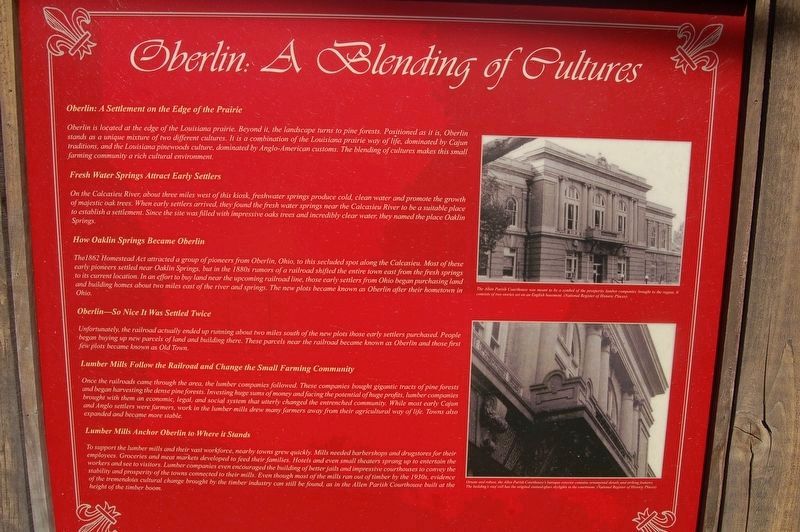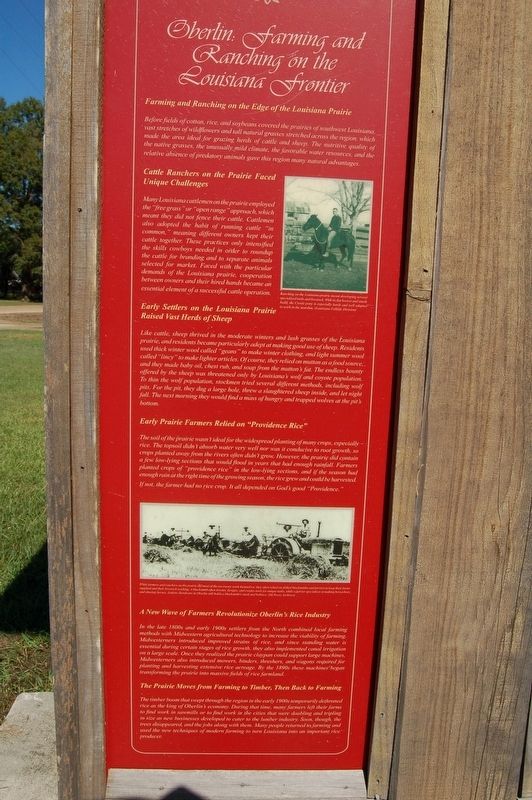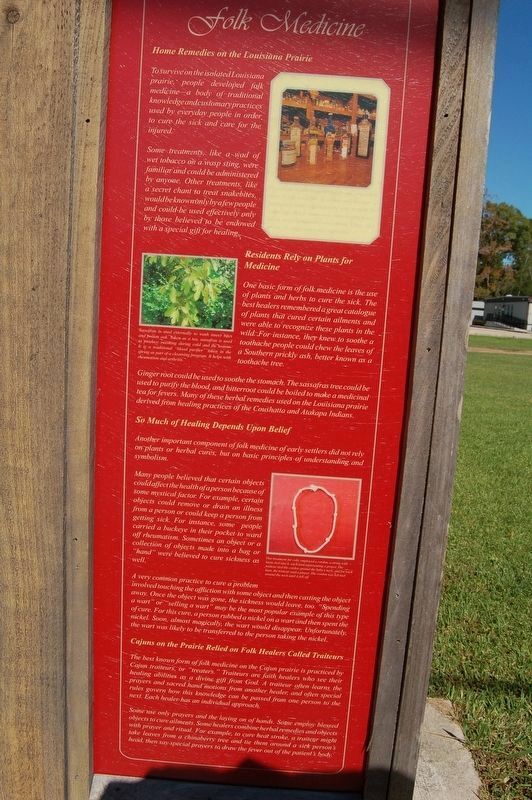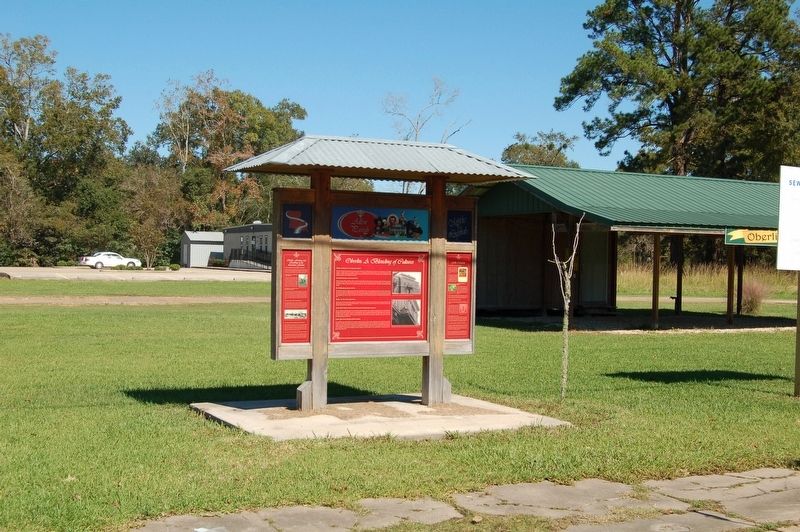Oberlin in Allen Parish, Louisiana — The American South (West South Central)
Oberlin: A Blending of Cultures
Myths & Legends - Allen Parish
Oberlin: A Settlement on the Edge of the Prairie
Oberlin is located at the edge of the Louisiana prairie. Beyond it, the landscape turns to pine forests:. Positioned as it is, Oberlin stands as a unique mixture of two different cultures. It is a combination of the Louisiana prairie way of life, dominated by Cajun traditions, and the Louisiana pinewoods culture, dominated by Anglo-American customs. The blending of cultures makes this small farming community a rich cultural environment.
Fresh Water Springs Attract Early Settlers
On the Calcasieu River, about three miles west of this kiosk, freshwater springs produce cold, clean water and promote the growth of majestic oak trees. When early settlers arrived, they found the fresh water springs near the Calcasieu River to be a suitable place to establish a settlement. Since the site was filled with impressive oaks trees and incredibly clear water, they named the place Oaklin Springs.
How Oaklin Springs Became Oberlin
The 1862 Homestead Act attracted a group of pioneers from Oberlin, Ohio, to this secluded spot along the Calcasieu. Most of these early pioneers settled near Oaklin Springs, but in the 1880s rumors of a railroad shifted the entire town east from the fresh springs to its current location. In an effort to buy land near the upcoming railroad line, those early settlers from Ohio began purchasing land and building homes about two miles east of the river and springs. The new plots became known as Oberlin after their hometown in Ohio.
Oberlin-So Nice It Was Settled Twice
Unfortunately, the railroad actually ended up running about two miles south of the new plots those early settlers purchased. People began buying up new parcels of land and building there. These parcels near the railroad became known as Oberlin and those first few plots became known as Old Town.
Lumber Mills Follow the Railroad and Change the Small Farming Community
Once the railroads came through the area, the lumber companies followed. These companies bought gigantic tracts of pine forests and began harvesting the dense pine forests. Investing huge sums of money and facing the potential of huge profits, lumber companies brought with them an economic, legal, and social system that utterly changed the entrenched community. While most early Cajun and Anglo settlers were farmers, work in the lumber mills drew many farmers away from their agricultural way of life. Towns also expanded and became more stable.
Lumber Mills Anchor Oberlin to Where it Stands
To support the lumber mills and their vast workforce, nearby towns
grew quickly. Mills needed barbershops and drugstores for their
employees. Groceries and meat markets developed to feed their families. Hotels and even small theaters sprang up to entertain the
workers and see to visitors. Lumber companies even encouraged the building of better jails and impressive courthouses to convey the
stability and prosperity of the towns connected to their mills. Even though most of the mills ran out of timber by the 1930s, evidence
of the tremendous cultural change brought by the timber industry can still be found, as in the Allen Parish Courthouse built at the
height of the timber boom.
Farming and Ranching on the Edge of the Louisiana Prairie
Before fields of cotton, rice, and soybeans covered the prairies of southwest Louisiana, vast stretches of wildflowers and tall natural grasses stretched across the region, which made the area ideal for grazing herds of cattle and sheep. The nutritive quality of the native grasses, the unusually mild climate, the favorable water resources, and the relative absence of predatory animals gave this region many natural advantages.
Cattle Ranchers on the Prairie Faced Unique Challenges
Many Louisiana cattlemen on the prairie employed the 'free
grass” or "open range" approach, which meant they did not fence their cattle. Cattlemen also adopted the habit of running cattle "in common," meaning different owners kept their cattle together. These practices only intensified the skills cowboys needed in order to roundup the cattle for branding and to separate animals selected for market. Faced with the particular demands of the Louisiana prairie, cooperation between owners and their hired hands became as essential element of a successful cattle operation.
Early Settlers on the Louisiana Prairie Raised Vast Herds of Sheep
Like cattle, sheep thrived in the moderate winters and lush grasses of the Louisiana prairie, and residents became particularly adept at making good use of sheep. Residents used thick winter wool called "geans" to make winter clothing, and light summer wool called "lincy" to make lighter articles. Of course, they relied on mutton as a food sourre, and they made baby oil, chest rub, and soap from the mutton's fat. The endless bounty offered by the sheep was threatened only by Louisiana's wolf and coyote population. To thin the wolf population, stockmen tried several different methods, including wolf pits. For the pit, they dug a large hole, threw a slaughtered sheep inside-and let night fall. The next morning they would find a mass of hungry and trapped wolves at the pit bottom.
Early Prairie Farmers Relied on "Providence Rice"
The soil of the Prairie wasn't ideal for the widespread planting of many crops. especially - rice. The topsoil didn't absorb water very well nor was it conducive to root growth, so crops planted away from the rivers often didn't grow. However the prairie did contain a few, low-lying sections that would flood in years that had enough rainfall. Farmers planted crops of "providence rice" in the low-lying sections, and if the season had enough rain at the right time of the growing season; the rice grew and could be harvested. If not, the farmer had no rice crop. It all depended on God's good "Providence".
A New Wave of Farmers Revolutionize Oberlin's Rice Industry
In the late 1800s and early 1900s settlers from the North combined total farming methods with Midwestern agricultural technology to increase the viability of farming. Midwesterners introduced improved strains of rice, and since standing water is essential during certain stages of rice growth, they also implemented canal irrigation on o large scale. Once they realized the prairie claypan could support large machines, Midwesterners also introduced mowers, binders, thrashers, and wagons required for planting and harvesting extensive rice acreage. By the 1890s these machines began transforming the prairie into massive fields of rice farmland.
The Prairie Moves from Farming to Timber, Then Back to Farming
The timber boom that swept through the region in the early 1900s temporarily dethroned rice as the king of Oberlin's economy. During that time, many farmers left their farms to find work in sawmills or to find work in the cities that were doubling and tripling in size as new businesses developed to cater to the lumber industry. Soon, though the trees disappeared, and the jobs along with them. Many people returned to farming and used the new techniques of modern farming to turn Louisiana into an important rice producer.
Home Remedies on the Louisiana Prairie
To survive on the isolated Louisiana prairie, people developed folk medicine - a body of traditional knowledge and customary practices used by everyday people in order to cure the sick and care for the injured.
Some treatments, like a wad of wet tobacco on a wasp sting, were familiar and could be administered by anyone. Other treatments, like a secret chant to treat snakebites, would be known by only a few people and could be used effectively only by those believed to be endowed with a special gift for healing.
Residents Rely on Plants for Medicine
One basic forms of folk medicine is the use of plants and herbs to cure the sick. The best healers remembered a great catalogue of plants that cured certain ailments and were able to recognize these plants in the wild. For instance, they knew to soothe a toothache people could chew the leaves of a Southern prickly ash, better known as a toothache tree.
Ginger root could be used to soothe the stomach. The sassafras tree could be used to purify the blood, and bitterroot could be boiled to make a medicinal tea for fevers. Many of these herbal remedies used on the Louisiana prairie derived from healing practice's of the Coushatta and Atakapa Indians.
So Much of Healing Depends on Belief
Another important component of folk medicine of early settlers did not rely on plants or herbal cures but on basic principles of understanding and symbolism.
Many people believed that certain objects could affect the health of a person because of some mystical factor. For example, certain objects could remove or drain an illness from a person or could keep person from getting sick. For instance, some people carried a buckeye in their pocket to ward off rheumatism. Sometimes an object or a collection of objects made into a bag or "hand" were believed to cure sickness as well.
A very common practice to cure a problem involved touching the affliction with some object and then casting the object away. Once the object was gone, the sickness would leave too. "Spending a wart" or "selling a wart" may be the most popular example of this type of cure. For this cure, a person rubbed a nickel on a wart and then spent the nickle. Soon almost magically, the wart would disappear. Unfortunately, the wart was likely to be transferred to the person taking the nickel.
Cajuns on the Prairie Relied on Folk Healers Called Traiteurs
The best known form of folk medicine on the cajun prairie is practiced by Cajun traiteurs, or "treaters." Traiteurs are healers who see their healing abilities as a divine gift from God. A traiteur often learns the prayers and sacred hand motions from another: healer and often special rules govern how this knowledge can be passed from one person to the next. Each healer has an individual approach.
Some healers use only prayers and the laying on of hands. Some employ blessed objects to cure ailments. Some healers combine herbal remedies and objects with prayer and ritual. For example, to cure heat stroke, a traiteur might take leaves from a chinaberry tree and tie them around a sick person's head, then say a special prayer to draw the fever out of the patient's body.
Erected by Louisiana Myths and Legends Byways. (Marker Number 17.)
Topics and series. This historical marker is listed in this topic list: Settlements & Settlers. In addition, it is included in the Louisiana Myths & Legends Byway series list.
Location. 30° 37.233′ N, 92° 45.962′ W. Marker is in Oberlin, Louisiana, in Allen Parish. Marker is at the intersection of 6th Avenue (Louisiana Route 26) and North Sixth Street on 6th Avenue. Touch for map. Marker is in this post office area: Oberlin LA 70655, United States of America. Touch for directions.
Other nearby markers. At least 8 other markers are within 11 miles of this marker, measured as the crow flies. St. Paul Baptist Church (approx. 6 miles away); The Coushatta People (approx. 7.7 miles away); 1st. Lt. Douglas Bernard Fournet (approx. 8.8 miles away); Elton Veterans Memorial (approx. 10˝ miles away); 1st. Lt. Douglas B. Fournet (approx. 10˝ miles away); Kinder War Monument (approx. 10˝ miles away); Kinder: The Crossroads to Everywhere (approx. 10˝ miles away); Great Louisiana Maneuvers' Blue Army Headquarters (approx. 10.6 miles away).
Credits. This page was last revised on February 24, 2024. It was originally submitted on November 9, 2018, by Cajun Scrambler of Assumption, Louisiana. This page has been viewed 571 times since then and 84 times this year. Photos: 1, 2, 3, 4. submitted on November 9, 2018.



